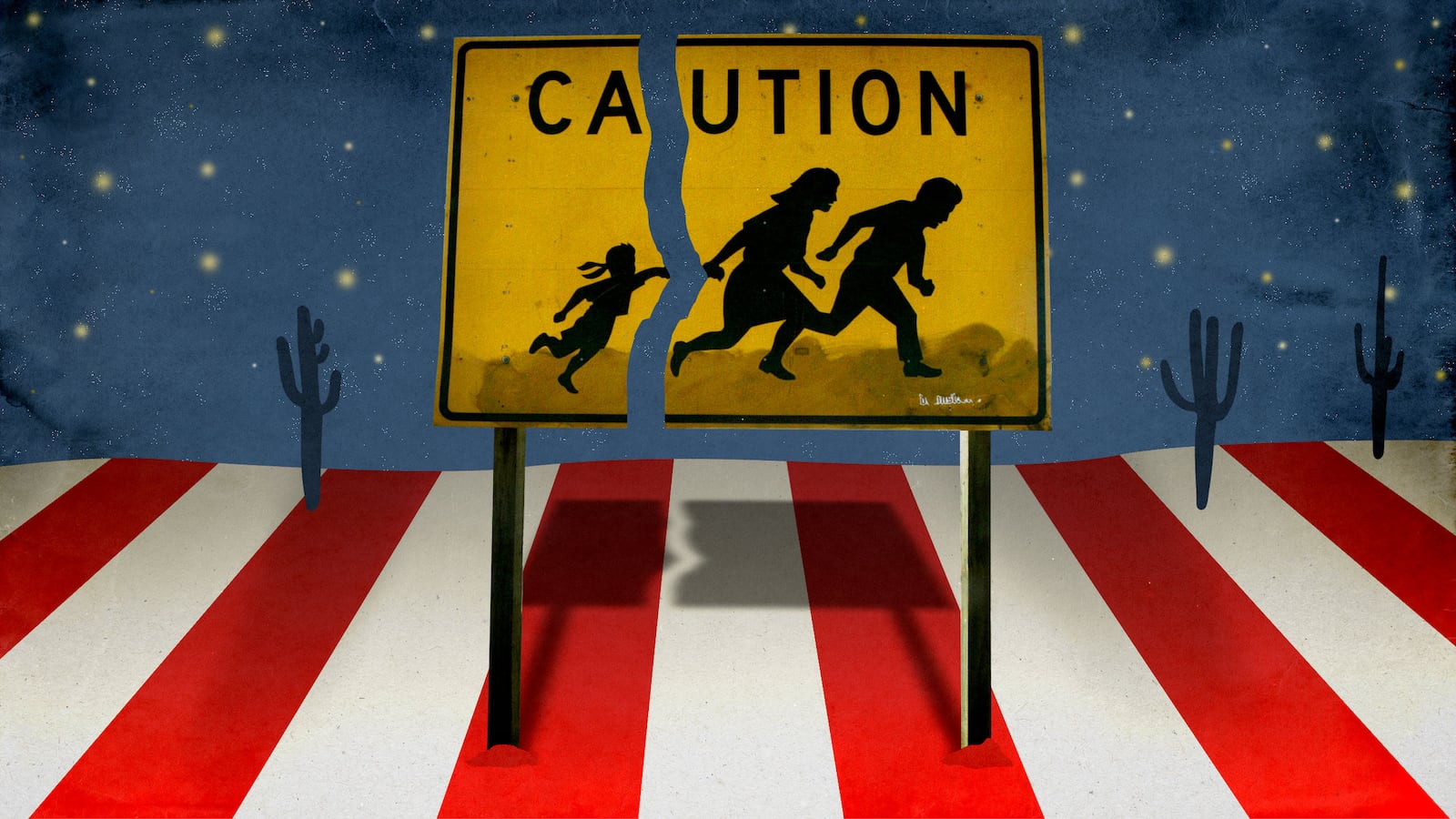The images and audio are unforgettable and heartbreaking: Kids as young as toddlers forcibly ripped apart from their parents, sitting dazed in gigantic metal cages. They’re the children of migrants seeking asylum—and all they want is their parents.
While there isn’t any precedent in psychological research for this particular situation that’s unfolding on the U.S. border, there’s been research on refugee situations and migrant parents being detained, as well as research on leaving kids without their parents for days at a time. And the research echoes this sentiment loud and clear: Children forcibly torn from their parents will face trauma that scars them for life.
“It’s really important to point out that family separation is undeniably harmful to children,” Julie M. Linton told The Daily Beast. “Family separation causes irreparable harm: It has short-term health implications and changes in bodily function, behavior, and working memory.”
Linton is the co-chair of the American Academy of Pediatrics Immigrant Health Special Interest Group and a practicing pediatrician at Wake Forest Baptist Health in Winston-Salem, North Carolina. She’s worked with immigrant children who have often dealt with trauma, not only in their home countries but also as they deal with the effects of being separated from parents who may be detained or deported. In previous months, such trauma was a result of parental detainment; now, it’s the children who are being detained themselves.
Research has shown that parental separation causes fundamentally jarring changes in how a child’s brain develops. In cases ranging from detained children in Canada to Britain to Australia, the patterns are resoundingly, eerily the same: Detained children separated from their parents face a trauma so extreme and severe that they go from distressed to depressed to emotionally lost—no matter how much food and water and toys they are plied with. Kids lose a sense of themselves, essentially becoming a shell of their usual character, to the point where when they are reunited with their parents, they are unrecognizable.
These fundamental changes in personality and neurological operations could be even more pronounced in immigrant kids in detention, because ostensibly, these children have already gone through trauma.
“They’re leaving traumatic circumstances in their home countries,” Judith Cohen, medical director of the Center for Traumatic Stress in Children and Adolescents at Allegheny General Hospital in Pittsburgh, Pennsylvania and a professor of psychiatry at Drexel University College of Medicine, pointed out.
Linton agreed. “That’s the myth of ‘whatever doesn’t kill you makes you stronger,’” she said. “Adding trauma onto trauma is concerning. These are children fleeing violence. They’re at risk in their country of origin, and their buffering support is stripped from them. That’s toxic stress, severe prolonged stress.”
Linton co-wrote a paper in 2017 in the journal Pediatrics where surveys indicated that 58 percent of children expressed fear “sufficient to merit protection under international law, and in another survey, 77 percent reported violence as the main reason for fleeing their country.”
That’s what ultimately makes this a one-two gut punch. These kids have already most likely escaped harrowing experiences and are seeking asylum for reasons that are already traumatizing: gangs, domestic violence, abuse, and more. They’ve gone through what can be assumed a harrowing journey, potentially having to travel through darkness and with strangers, having only their parent to latch onto.
That parent or parents—the one tie to their homeland, the one person they trust completely, the one way they can make sense of what is arguably a traumatic event in and of itself—is ripped from them, and they’re placed in an alien environment: chain-linked boxes that house a mattress and space blanket under the unblinking glare of fluorescent lights. It’s frightening for an adult, and even more so for a child who doesn’t know where they are, what has happened to them, why they’ve been separated from the only people they trust.
That double trauma puts kids at risk of having PTSD, anxiety, and depression, “potentially lasting the rest of their lives,” Cohen said. “They’re pre-disposed to develop trauma.”
In the short term, trauma plays out almost immediately with radical changes in children’s behavior. A child might become suddenly aggressive, or the opposite, crouching in the corner when something as harmless as a pen falls from a desk or a door opens suddenly. These kids have brains so highly on hyperdrive in search of cues for danger and distress that they barely have room in their minds for anything else—to the point where children emerging from traumatization show marked difficulty in memory, Linton said, with kids reporting poorer concentration levels and distractibility. That, in turn, has huge consequences for the rest of their lifetimes: lower memory retention can lead to lower grades in school, lower performances, reduced job aspirations, shrunken incomes, and potential poverty—a cycle that has been proven to be difficult to circumvent and escape, particularly for minorities.
That Pediatrics paper co-authored by Linton might sum it up best:
<p><em>These reports describe prisonlike conditions; inconsistent access to quality medical, dental, or mental health care; and lack of appropriate developmental or educational opportunities. Parents interviewed for these [earlier] reports described regressive behavioral changes in their children, including decreased eating, sleep disturbances, clinginess, withdrawal, self-injurious behavior, and aggression. Parents exhibited depression, anxiety, loss of locus of control, and a sense of powerlessness and hopelessness. Parents often faced difficulty parenting their children and subsequently experienced strained parent–child relationships. Detained families’ sense of isolation and desperation were intensified by detention center practices that created communication barriers with the outside world (eg, expensive telephone service and lack of Internet services). Additionally, detainees reported being anxious about the lack of access to legal advocates.</em></p>
Cohen said that the brain and family environment play a dual role here in creating a traumatic experience that causes lifelong issues. “A parent has a very proven protective impact on children on many levels,” she explained. “We all know the impact of a child crying. A mother’s voice, a mother’s touch can easily soothe a child. They look to a parent to interpret external cues—it’s OK, honey, you’re safe—and the child relaxes and calms down.
“If a parent is frightened, the child gets aroused,” she continued. “A parent’s voice and a parent’s touch is important. You can give them [a child] food, shelter, toys, a place to sleep, but that’s not the same as a known parent who is attached to the child who can tell them they’re OK.”
Cohen explained that when a child’s parent is torn from them, their body senses danger and goes into overdrive, attempting to not only make sense of the situation but to also try to self-protect. The amygdala, which Cohen described as the Grand Central Station of the brain, helps to organize cues. “The amygdala figures out if there’s something wrong here: Do I have to pay attention to it, or can I ignore it?”
In traumatized children who are separated from their families, that amygdala is in hyper alert, constantly looking at the immediate environment as dangerous. “The amygdala is impaired”—which makes its highway to the premedial frontal cortex, which normally helps interpret the response to these cues, go haywire.
An overactive amygdala/premedial frontal cortex connection can be dangerous. The stronger the connection, the more protected children are from negative effects; the weaker the connection, the more at risk these children are in developing PTSD, depression, and even suicide, Cohen said.
That can be even more intense in children who are younger and rely on their parents for support. For adolescents, who are a bit more mature, the circuitry isn’t on as high alert, but there is reason to believe that the normal maturity response and emotional regulation of the brain is delayed. In other words: Even teenagers who might be better equipped to handle time away from their parents are traumatized without their support systems, delaying their neural development to the point of potentially stymieing their growth as adults.
In short: “Parental involvement is critical, and parents are a critical factor in effectively dealing with trauma,” Cohen said.
Therapy can help, Cohen said, pointing to cognitive behavioral therapy, which has been found to be effective for victims of trauma ranging from domestic and sexual violence to refugee trauma. Cohen added that resilience is a key factor in determining how children recover, and some children simply have more resilience than others.
For many, however, the damage is done. “For some of them, the impact is that they’re always looking for when the next danger is going to come,” Cohen said. “They have difficulty distinguishing between safety and danger even if their parent is back with them.”
Regardless of age, these kids will also deal with trust issues with their parents. “They’ll think that ‘My parents couldn't keep me safe, how can they keep me safe in the future?’” Cohen said. “They have to relearn that parents can be trusted,” along with other people and the broader system they are surrounded by.
Kids might also have to deal with bullying alongside their trauma. “They [formerly detained kids] might be embarrassed about how they respond to trauma,” Linton said. “Imagine a kid who freaks out and drops something like a pen [after hearing a noise that spooks them]. They’re afraid and embarrassed, and others respond” by making fun of them. School can be a high-stakes social environment as it is, and having a kid who freaks out is ripe for teasing and bullying, particularly if paired with lower educational skills and impaired ability to communicate.
Even if the detained kids are let out of their cages as you read this, the damage has already been done. Problems in long-term health are not uncommon among people who have undergone trauma as children; being separated from parents can lead to anxiety, depression, and heart disease, risk factors that can incite earlier death.
And the fact that many of these kids are young is especially harmful, say both Linton and Cohen.
Is there an age where the brain is best buffered from harmful effects in development? No, Linton says.
“We have no evidence that any amount of time is safe for children,” Linton said. “Even short periods of detention can be harmful. Separation from parents is a serious stressful event.”
That’s not even mentioning the stress of children being placed into foster care and bussed from family to family, in many cases without stability. “When unaccompanied children are released to sponsors all over the country, they’re left to try to adjust,” Linton said. Kids can be given all the tools—books, toys, mental health care, an education, legal representation—but the fact that they are dealing with the loss of their parent(s) makes it worse.
“These kids are irreparably harmed,” Cohen sighed. “They’re children who have gone through unimaginable trauma.”






